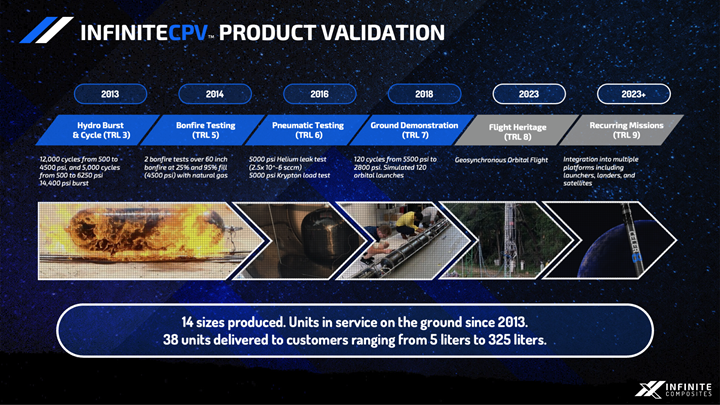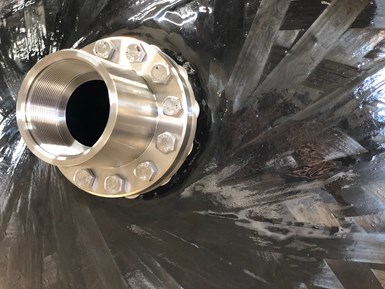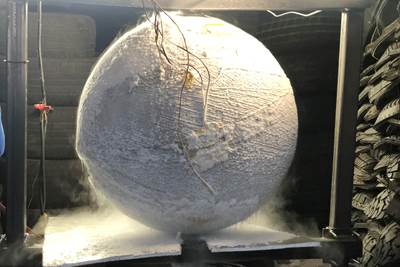Infinite Composites: Type V tanks for space, hydrogen, automotive and more
After a decade of proving its linerless, weight-saving composite tanks with NASA and more than 30 aerospace companies, this CryoSphere pioneer is scaling for growth in commercial space and sustainable transportation on Earth.
Infinite Composites (Tulsa, Okla., U.S.) was founded in 2010 and delivered its first Type V composite pressure vessels in 2013. Compared to Type I, II and III tanks using metal, and Type IV tanks using a plastic liner, Type V pressure vessels offer the lightest weight, featuring a fully composite construction reinforced primarily with carbon fiber but without a liner. However, because the liner serves as a barrier to prevent gases and cryogenic liquids from permeating into the composite laminate at high pressures — e.g., up to 14,000 psi/993 bar — building linerless tanks that can perform reliably for potentially thousands of pressurization cycles is no easy feat.
Infinite Composites has succeeded, supplying Type V tanks sized 5 to 325 liters for use in spacecraft, aviation, ground transportation and industrial gas applications. The company has tanks certified to AIAA S-081B-2018 for space systems and is working with multiple customers to develop Type V tanks for hydrogen storage, including for cryogenic liquid hydrogen (LH2). “We’ve completed 18,000 pressure cycles for Federal Motor Vehicle Safety Standards [FMVSS] 304 testing,” says Matt Villarreal, CEO of Infinite Composites. “We’ve done post-crash survivability and bonfire testing. We’ve proven our technology in a lot of different applications, and right now we’re focused on completing qualifications and scaling for serial production.”
NGV to space
Infinite Composites’ first Type V tanks were for natural gas vehicles (top), but soon began developing tanks for space such as the CryoSphere (bottom) to store liquid propellants at cryogenic temperatures as low as -180°C. Photo Credit: Infinite Composites
As explained in the 2020 article, “Developing a linerless, all-composite spherical cryotank,” Infinite Composites got its start when the founders built a Formula One-style race car powered by compressed natural gas (CNG) — reportedly the world’s first — and experienced first-hand how the weight of the all-metal CNG fuel tank (≈10% of the entire vehicle weight) reduced the car’s efficiency, demanding multiple refuelings during competition. As they researched lighter weight alternatives, explains Villarreal, “we became convinced that Type V tanks could revolutionize space exploration and sustainable transportation.”
Most of the company’s early tanks were in CNG applications, says Villarreal, “but in 2016, we decided that space was the best fit for us because the natural gas vehicle [NGV] market was very commoditized and demanded scale. Around that same time, SpaceX reached out to us, and the NASA Marshall Space Flight Center also wanted some tanks. So, we changed the company name to Infinite Composites to reflect a broader scope of applications. Our mission is to make Type V composite pressure vessels as ubiquitous as metal tanks. We currently have projects for rockets, LEO satellites, GEO satellites, a lunar lander, unmanned aerial vehicles, hypersonic vehicles and hydrogen-powered aircraft, as well as specialized niche programs.”
Why Type V tanks?
Linerless composite pressure vessels eliminate the weight of a metal or plastic liner as well as the logistics and manufacturing cost/time. “This also eliminates issues with entrapped air between the liner and composite overwrap and other quality issues, which have led to tank failures in the past,” says Villarreal. “We also eliminate the issue of liner fatigue failure, so we get a longer cycle life out of the tanks.”
Villarreal claims Infinite Composites Type V tanks have up to 90% less mass than typical all-metal tanks used to store and transport industrial gases and up to 40% less mass compared to composite-overwrapped metal pressure vessels (COPVs) traditionally used in space vehicles. “We can also typically provide at least a 70% reduction in lead time and up to a 50% reduction in cost versus traditional COPVs,” he adds. However, he concedes that Type V tanks will have higher permeation than pressure vessels with metal liners. There is also less flight heritage with Type V tanks, but that is beginning to change.
Infinite Composites cite Type V tanks offer up to 40% less mass, 50% lower cost and 70-80% reduction in lead time versus COPVs commonly used in space vehicles.
Manufacturing and materials for Type V tanks
Typical for most composite pressure vessels, Infinite Composites uses filament winding to make its tanks. “We have an automated process that can go overnight without anybody having to interfere with it or watch it,” says Villarreal. “We use a removable mandrel and a variety of proprietary resin systems that give us the combination of permeation barrier and load-bearing structure for the carbon fiber composite laminate. We can tailor those resins to be compatible with different applications, for example with different high pressure and cryogenic fluids such as helium, hydrogen, methane, high-test peroxide or nitrous oxide.”
The company also uses graphene additives from Universal Matter (formerly Applied Graphene Materials, Cleveland, U.K.) in its resins. “We've seen improvements in both the interlaminar fracture toughness and in permeation resistance capabilities,” notes Villarreal. “We've gotten to 2.5 x 10-6 standard cubic centimeters per minute [SCCM] for a permeation rate, so we're getting closer to parity with some of the metal tanks for permeability resistance.”
Carbon fiber, including Toray (Tokyo, Japan) T800 and T1100 fibers, are the primary reinforcements but Infinite Composites has also used basalt, glass and other fibers in different tank applications.
Infinite Composites has developed technology for the metallic boss-CFRP tank interface that mitigates thermal expansion mismatch and ensures attachment on a nanoscale level for 20 years of service. Photo Credit: Infinite Composites
Another key part of such a pressure vessel is the metallic boss interface which is attached to the composite structure for connecting to external valves and fueling systems. The boss receives end loading during transportation, as well as large temperature swings during pressurization cycles, and its bond with the composite structure is critical. Infinite Composites uses a proprietary process for metallic bosses bonded to the composite laminate that mitigates the mismatch in thermal expansion between the dissimilar materials. This enables intimate bonding on a nanoscale level which can remain intact even after 20 years of daily use.
These pressure vessels have also passed numerous tests, including burst pressure up to 993 bar, 816°C bonfire testing, cryogenic testing to -207°C, pneumatic testing to simulate 200 launches and landings of an orbital class rocket and pressure/temperature cycling simulating 20 years of service. “We’ve also done filling tests with cryogens like liquid oxygen and liquid helium,” says Villarreal. “Our tank construction has proven its performance throughout. We have made tanks all the way down to 2.5 inches in diameter for NASA Langley and 325-liter tanks that measure roughly 2 feet in diameter by 5 feet long.”
Wet filament winding vs. towpreg, 3D printing
Infinite Composites uses the most common process for making pressure vessels — filament winding using liquid resin —versus winding of towpreg or prepreg tapes. “We have used towpreg, but we prefer the flexibility of being able to use whatever customized resin we want and not be restricted to one matrix system in a prepreg, because that’s not optimal for developing new fluid compatibilities,” explains Villarreal. “We prefer the flexibility in the materials that wet winding gives.”
He adds that the automated tape winding or fiber placement (AFP) equipment required to layup prepreg is also very expensive. “The process is also more complicated and not as scalable as wet filament winding using multi-spindle machines,” says Villarreal. “However, we’re working on a project with Dr. Ranji Vaidyanathan at Oklahoma State University right now for manufacturing in space, and that type of application may require towpreg because mixing liquid resins in space doesn’t seem practical.”
“What I think has a lot of promise is continuous fiber 3D printing,” he continues. “I think that will be the most advantageous kind of manufacturing technology going forward because you could print the mandrel where it functions as part of the carbon fiber structure. And you could easily do this in a fully automated way in a space environment. You also can get some very interesting structures with internal features that you can't really get with any other type of manufacturing process right now. So that's my pick for the future of manufacturing composites including composite pressure vessels.”
Growth in New Space
Infinite Composites Type V tanks burst tested for 700-bar hydrogen storage (left) and nitrous oxide (NOX) and helium gas raceway for a space vehicle fuel system (right). Photo Credit: Infinite Composites
The New Space market is exploding, says Villarreal, extending beyond the traditional cryofuel and oxidizer tanks for rockets and launch vehicles to propellant tanks for satellites and lunar landers, as well as pressurized tanks for space fueling depots, space stations and habitats. “These applications have to go to Type V tanks because they are so mass-sensitive. It’s a direct trade-off — every pound in a launch vehicle is a pound of paying cargo left on the ground. They can be giving up millions of dollars by having multiple, heavier tanks.” The same calculus applies to satellites and lunar landers.
Infinite Composites is supplying tanks for multiple LEO and GEO satellites as well as a lunar lander, all of which should be in space by 2024. “Our tanks are used in the propulsion systems, which typically use gases like xenon or krypton,” says Villarreal.
“But we're increasingly getting more customers wanting larger and larger tanks,” says Villarreal. “We've had interest from groups that want all-composite tanks with more than a 36-foot-diameter for their launch vehicles. We can't make tanks that large yet, but the interest is out there. I think that's where the market is going. And space continues to be the biggest growth sector for us, although hydrogen applications are picking up as well.”
Hydrogen, converging solutions
Infinite Composites is doing work with multiple players in the hydrogen-powered aircraft space, delivering 10 Type V composite tanks for testing. “We’re also working with a group called Skydweller [Oklahoma City, Okla., U.S.] that is building UAVs for ultralong flights,” says Villarreal. “We’re replacing some of their battery capacity with hydrogen tanks, and doing some great studies with them, looking at 350-bar compressed gas tanks as well as a joint proposal to develop liquid hydrogen tanks for UAVs.”
Infinite Composites has tested and is continuing to explore non-cylindrical tank shapes. Photo Credit: Infinite Composites
Will these liquid hydrogen tanks be like those already used in space launch vehicles, or more like the all-metal dewars being developed for hydrogen-powered heavy trucks? “We’ve done some testing with vacuum-insulated dewars,” says Villarreal. “I think one of the challenges for these is that the metal structures in the tank are just transferring heat. In our testing with liquid helium for a liquid hydrogen project, all the lines were stainless steel and if there was even a tiny break in the insulation — or any spot that was less insulated — then the liquid helium would just boil off. I think all-composite tanks are going to be the big winner because you can avoid most of that heat transfer through the tanks, especially if we do go to vacuum-insulated tanks for such applications.”
Villarreal also notes that currently, Type V tanks used for transportation on Earth experience far more pressure cycles (tens of thousands) compared to space vehicle tanks (tens to hundreds). That may change with increased use of reusable launch vehicles and the vision for refueling stations in space to extend mission duration for space tugs and other spacecraft. “But the major difference is the risk of damage from external sources,” he says. Tanks for spacecraft are manufactured to be extremely lightweight and able to withstand launch, but not necessarily impact-resistant for everyday service in a ground or airborne terrestrial vehicle. “That drives significantly more rigorous testing to mitigate,” Villarreal adds. As described above, Infinite Composites has done this type of testing thanks to its origin in NGVs and in its more recent hydrogen tank developments — and sees technologies coming together.
“We’re at the intersection of all these markets — hydrogen for more sustainable aviation and global transportation, industrial applications for gas storage and transport and New Space — and we see the technology for these applications converging. We're even selling some of the same tanks to hydrogen aircraft programs that we would to space vehicle groups because they meet all the same standards and safety factors and went through the same testing. I don't think there will be a big difference in the technologies that are being used in these markets within five years or so.”
“The Type V tanks that we produce already exceed the DOE targets for gravimetric efficiency for hydrogen storage in vehicles, and they’re exceeding the targets previously set for space applications,” says Villarreal. “They're lighter than anything else on the market. I see that coming together and providing the solution for energy storage for propulsion in the future.”
Related Content
Next-generation airship design enabled by modern composites
LTA Research’s proof-of-concept Pathfinder 1 modernizes a fully rigid airship design with a largely carbon fiber composite frame. R&D has already begun on higher volume, more automated manufacturing for the future.
Read MorePlant tour: Spirit AeroSystems, Belfast, Northern Ireland, U.K.
Purpose-built facility employs resin transfer infusion (RTI) and assembly technology to manufacture today’s composite A220 wings, and prepares for future new programs and production ramp-ups.
Read MoreCombining multifunctional thermoplastic composites, additive manufacturing for next-gen airframe structures
The DOMMINIO project combines AFP with 3D printed gyroid cores, embedded SHM sensors and smart materials for induction-driven disassembly of parts at end of life.
Read MoreA new era for ceramic matrix composites
CMC is expanding, with new fiber production in Europe, faster processes and higher temperature materials enabling applications for industry, hypersonics and New Space.
Read MoreRead Next
NCC’s all-composite Type V tank demonstrates future composite space tank technology
SpaceTank project delivers a 96-liter carbon fiber composite tank with 4.0-5.50-millimeter nominal wall thickness for 30% weight savings in launch vehicle and satellite propellant tank applications.
Read MoreViritech and Haydale pursue new functionalized materials for Type V composite vessels for hydrogen storage
Goal is considerable weight savings via lightweight, impermeable pressure vessels without a liner, further advance in Graph-Pro structural storage tanks with integrated fixation.
Read MoreDeveloping a linerless, all-composite, spherical cryotank
Infinite Composites Technologies’ Type V pressure vessel for storing cryogenic space launch vehicle propellants shows promise for eliminating elusive microcracking issues.
Read More





























